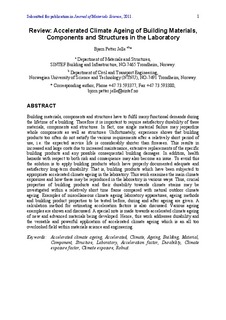Accelerated Climate Ageing of Building Materials, Components and Structures in the Laboratory
Journal article, Peer reviewed
Submitted version

Permanent lenke
http://hdl.handle.net/11250/2450396Utgivelsesdato
2012Metadata
Vis full innførselSamlinger
- Publikasjoner fra CRIStin - SINTEF AS [5801]
- SINTEF Community [2247]
Originalversjon
10.1007/s10853-012-6349-7Sammendrag
Building materials, components and structures have to fulfil many functional demands during the lifetime of a building. Therefore, it is important to require satisfactory durability of these materials, components and structures. In fact, one single material failure may jeopardize whole components as well as structures. Unfortunately, experience shows that building products too often do not satisfy the various requirements after a relatively short period of use, i.e. the expected service life is considerably shorter than foreseen. This results in increased and large costs due to increased maintenance, extensive replacements of the specific building products and any possible consequential building damages. In addition, health hazards with respect to both risk and consequence may also become an issue. To avoid this, the solution is to apply building products which have properly documented adequate and satisfactory long-term durability. That is, building products which have been subjected to long-term natural outdoor climate exposure or appropriate accelerated climate ageing in the laboratory. This study examines the main climate exposures and how these may be reproduced in the laboratory in various ways. Thus, crucial properties of building products and their durability towards climate strains may be investigated within a relatively short time frame compared with natural outdoor climate ageing. Examples of miscellaneous climate ageing laboratory apparatuses, ageing methods and building product properties to be tested before, during and after ageing are given. A calculation method for estimating acceleration factors is also discussed. Various ageing examples are shown and discussed. A special note is made towards accelerated climate ageing of new and advanced materials being developed. Hence, this study addresses durability and the versatile and powerful application of accelerated climate ageing which is an all too overlooked field within materials science and engineering
Utgiver
SpringerTidsskrift
Journal of Materials ScienceOpphavsrett
© Preprint version the authorsBeslektede innførsler
Viser innførsler beslektet ved tittel, forfatter og emneord.
-
The Effect of Local Climate Data and Climate Change Scenarios on the Thermal Design of Office Buildings in Denmark
Petersen, Steffen (SINTEF Proceedings;5, Chapter; Peer reviewed; Conference object, 2020)The effect of climate change on Danish office building energy performance was investigated. Local mean weather data and national design reference year are morphed into future weather files, and the output from a total of ... -
Safety climate as an indicator for major accident risk: Can we use safety climate as an indicator on the plant level?
Kvalheim, Sverre Andreas; Antonsen, Stian; Haugen, Stein (Journal article; Peer reviewed, 2016)Measuring safety climate is regarded a proactive approach to safety management. With increased focus on developing indicators for major accidents, there is a need to critically assess the effectiveness of current practices ... -
Predominant Climate Exposure Strains - Thermal Degradation Testing Compared to Historical and Future Climate Scenarios
Rüther, Petra; Gradeci, Klodian; Sletnes, Malin (Chapter; Conference object, 2020)The service life of a building or structure is often presumed to be 60 years. Products used in the building envelope are often covered by a facade material on the exterior side. Hence, the failure of these products is not ...